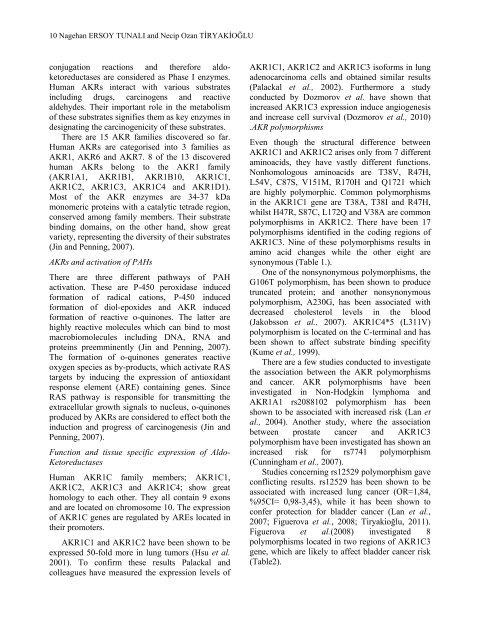Vol 9 No1 - Journal of Cell and Molecular Biology - Haliç Üniversitesi
Vol 9 No1 - Journal of Cell and Molecular Biology - Haliç Üniversitesi
Vol 9 No1 - Journal of Cell and Molecular Biology - Haliç Üniversitesi
Create successful ePaper yourself
Turn your PDF publications into a flip-book with our unique Google optimized e-Paper software.
10 Nagehan ERSOY TUNALI <strong>and</strong> Necip Ozan TİRYAKİOĞLU<br />
conjugation reactions <strong>and</strong> therefore aldoketoreductases<br />
are considered as Phase I enzymes.<br />
Human AKRs interact with various substrates<br />
including drugs, carcinogens <strong>and</strong> reactive<br />
aldehydes. Their important role in the metabolism<br />
<strong>of</strong> these substrates signifies them as key enzymes in<br />
designating the carcinogenicity <strong>of</strong> these substrates.<br />
There are 15 AKR families discovered so far.<br />
Human AKRs are categorised into 3 families as<br />
AKR1, AKR6 <strong>and</strong> AKR7. 8 <strong>of</strong> the 13 discovered<br />
human AKRs belong to the AKR1 family<br />
(AKR1A1, AKR1B1, AKR1B10, AKR1C1,<br />
AKR1C2, AKR1C3, AKR1C4 <strong>and</strong> AKR1D1).<br />
Most <strong>of</strong> the AKR enzymes are 34-37 kDa<br />
monomeric proteins with a catalytic tetrade region,<br />
conserved among family members. Their substrate<br />
binding domains, on the other h<strong>and</strong>, show great<br />
variety, representing the diversity <strong>of</strong> their substrates<br />
(Jin <strong>and</strong> Penning, 2007).<br />
AKRs <strong>and</strong> activation <strong>of</strong> PAHs<br />
There are three different pathways <strong>of</strong> PAH<br />
activation. These are P-450 peroxidase induced<br />
formation <strong>of</strong> radical cations, P-450 induced<br />
formation <strong>of</strong> diol-epoxides <strong>and</strong> AKR induced<br />
formation <strong>of</strong> reactive o-quinones. The latter are<br />
highly reactive molecules which can bind to most<br />
macrobiomolecules including DNA, RNA <strong>and</strong><br />
proteins preemminently (Jin <strong>and</strong> Penning, 2007).<br />
The formation <strong>of</strong> o-quinones generates reactive<br />
oxygen species as by-products, which activate RAS<br />
targets by inducing the expression <strong>of</strong> antioxidant<br />
response element (ARE) containing genes. Since<br />
RAS pathway is responsible for transmitting the<br />
extracellular growth signals to nucleus, o-quinones<br />
produced by AKRs are considered to effect both the<br />
induction <strong>and</strong> progress <strong>of</strong> carcinogenesis (Jin <strong>and</strong><br />
Penning, 2007).<br />
Function <strong>and</strong> tissue specific expression <strong>of</strong> Aldo-<br />
Ketoreductases<br />
Human AKR1C family members; AKR1C1,<br />
AKR1C2, AKR1C3 <strong>and</strong> AKR1C4; show great<br />
homology to each other. They all contain 9 exons<br />
<strong>and</strong> are located on chromosome 10. The expression<br />
<strong>of</strong> AKR1C genes are regulated by AREs located in<br />
their promoters.<br />
AKR1C1 <strong>and</strong> AKR1C2 have been shown to be<br />
expressed 50-fold more in lung tumors (Hsu et al.<br />
2001). To confirm these results Palackal <strong>and</strong><br />
colleagues have measured the expression levels <strong>of</strong><br />
AKR1C1, AKR1C2 <strong>and</strong> AKR1C3 is<strong>of</strong>orms in lung<br />
adenocarcinoma cells <strong>and</strong> obtained similar results<br />
(Palackal et al., 2002). Furthermore a study<br />
conducted by Dozmorov et al. have shown that<br />
increased AKR1C3 expression induce angiogenesis<br />
<strong>and</strong> increase cell survival (Dozmorov et al., 2010)<br />
.AKR polymorphisms<br />
Even though the structural difference between<br />
AKR1C1 <strong>and</strong> AKR1C2 arises only from 7 different<br />
aminoacids, they have vastly different functions.<br />
Nonhomologous aminoacids are T38V, R47H,<br />
L54V, C87S, V151M, R170H <strong>and</strong> Q1721 which<br />
are highly polymorphic. Common polymorphisms<br />
in the AKR1C1 gene are T38A, T38I <strong>and</strong> R47H,<br />
whilst H47R, S87C, L172Q <strong>and</strong> V38A are common<br />
polymorphisms in AKR1C2. There have been 17<br />
polymorphisms identified in the coding regions <strong>of</strong><br />
AKR1C3. Nine <strong>of</strong> these polymorphisms results in<br />
amino acid changes while the other eight are<br />
synonymous (Table 1.).<br />
One <strong>of</strong> the nonsynonymous polymorphisms, the<br />
G106T polymorphism, has been shown to produce<br />
truncated protein; <strong>and</strong> another nonsynonymous<br />
polymorphism, A230G, has been associated with<br />
decreased cholesterol levels in the blood<br />
(Jakobsson et al., 2007). AKR1C4*5 (L311V)<br />
polymorphism is located on the C-terminal <strong>and</strong> has<br />
been shown to affect substrate binding specifity<br />
(Kume et al., 1999).<br />
There are a few studies conducted to investigate<br />
the association between the AKR polymorphisms<br />
<strong>and</strong> cancer. AKR polymorphisms have been<br />
investigated in Non-Hodgkin lymphoma <strong>and</strong><br />
AKR1A1 rs2088102 polymorphism has been<br />
shown to be associated with increased risk (Lan et<br />
al., 2004). Another study, where the association<br />
between prostate cancer <strong>and</strong> AKR1C3<br />
polymorphism have been investigated has shown an<br />
increased risk for rs7741 polymorphism<br />
(Cunningham et al., 2007).<br />
Studies concerning rs12529 polymorphism gave<br />
conflicting results. rs12529 has been shown to be<br />
associated with increased lung cancer (OR=1,84,<br />
%95CI= 0,98-3,45), while it has been shown to<br />
confer protection for bladder cancer (Lan et al.,<br />
2007; Figuerova et al., 2008; Tiryakioğlu, 2011).<br />
Figuerova et al.(2008) investigated 8<br />
polymorphisms located in two regions <strong>of</strong> AKR1C3<br />
gene, which are likely to affect bladder cancer risk<br />
(Table2).

















